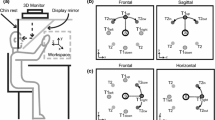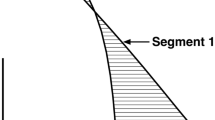Abstract
Visually triggered forearm movements were analyzed by an Information Theory approach. Human subjects made smooth movements which were characterized by moderate speeds, ranging about 100 degrees per second, by continuity in the position and velocity traces, and attainment of final average EMG levels before completion of the movement. We calculated the information transmitted by final position, biceps EMG, triceps EMG, and the ratio of the EMGs. The results were: (1) The information transmitted by final joint angle increased with number of targets but gradually levelled off. The maximum value was slightly over 3 bits, corresponding to an equivalent number of less than nine independent arm positions for a single movement. (2) The information transmitted by the ratio of the EMGs exceeds that transmitted by the biceps or triceps alone. (3) A previous theoretical prediction based on a spring model (Sakitt, 1980a) gives a moderately good fit to the experimental EMG ratio as a function of final position over a large range of angles. Our results lend consistency to two ideas about the nature of visually triggered forearm movements. First, our finding about the EMG ratio suggests that the basic motor program for final position is probably in terms of relative allocation of innervations, rather than looking up individual values. Second, single movements of this kind transmit surprisingly little information. If this is the case, it suggests that very fine accuracy is not achieved by a single program but requires feedback in order to program and execute additional movement.
Similar content being viewed by others
References
Asatryan, D.G., Feldman, A.G.: Biophysics of complex systems and mathematical models. Functional tuning of nervous system with control of movement or maintenance of a steady posture. 1. Mechanographic analysis of the work of the joint on execution of a postural task. Biophysics 10, 925–935 (1965)
Bizzi, E., Polit, A.: Characteristics of the motor programs underlying visually evoked movements. In: Posture and Movement. Talbot, R.E., Humphrey, D. (eds.). New York: Raven Press 1979
Bizzi, E., Polit, A., Morasso, P.: Mechanisms underlying achievement of final head position. J. Neurophysiol. 39, 435–444 (1976)
Brooks, V.B.: Introductory lecture to session III: Some examples of programmed limb movements. Brain Res. 71, 299–308 (1974)
Feldman, A.G.: Functional tuning of nervous system with control of movement or maintenance of a steady posture. II. Controllable parameters of the muscles. Biophysics 11, 565–578 (1966a)
Feldman, A.G.: Functional tuning of nervous system during control of movement or maintenance of a steady posture. III. Mechanographic analysis of the execution by man of the simplest motor tasks. Biophysics 11, 766–775 (1966b)
Fitts, P.M.: The information capacity of the human motor system in controlling the amplitude of movement. J. Exp. Psychol. 47, 381–391 (1954)
Garner, W.R., McGill, W.J.: The relation between information and variance analyses. Psychometrika 21, 219–228 (1956)
Kozlovskaya, I.B., Atkin, A., Horvath, F.E., Thomas, J.S., Brooks, V.B.: Preprogrammed and feedback-guided movements of monkeys. Behav. Biol. 12, 243–248 (1974)
Lestienne, F.: Effects of inertial load and velocity on the braking process of voluntary limb movements. Exp. Brain Res. 35, 407–418 (1979)
Lestienne, F., Polit, A., Bizzi, E.: Transition from movement to posture: An electromyographic study. Paper presented at the meeting for the Society of Neuroscience, St. Louis, Missouri, Nov. 1978
Lestienne, F., Polit, A., Bizzi, E.: From movement to posture. In: Psychology for motor behavior and sport. Nadeau, C.H. et al. (eds.), pp. 390–399. Champaign Illinois: Human Kinetics 1980
Polit, A., Bizzi, E.: Processes controlling arm movements in monkeys. Science 201, 1235–1237 (1978)
Polit, A., Bizzi, E.: Characteristics of motor programs underlying arm movement in monkeys. J. Neurophysiol. 42, 183–194 (1979)
Sakitt, B.: A spring model and equivalent neural network for arm posture control. Biological Cybern. 37, 227–234 (1980a)
Sakitt, B.: Visual-motor efficiency (VME) and the information transmitted in visual-motor tasks. Bull. Psychol. 16, 329–332 (1980b)
Sakitt, B., Lestienne, F., Zeffiro, T.: Control of forearm position: Information transmitted by the activities of the muscles acting on the elbow joint. Soc. Neurosci. Abstracts 6, 761 (1980)
Shannon, C.E.: The mathematical theory of communication. Bell. Syst. Techn. J. 27, 379–423; 623–656 (1948)
Author information
Authors and Affiliations
Additional information
Laboratoire de Physiologie Neurosensorielle, CNRS, Paris, France
Rights and permissions
About this article
Cite this article
Sakitt, B., Lestienne, F. & Zeffiro, T.A. The information transmitted at final position in visually triggered forearm movements. Biol. Cybern. 46, 111–118 (1983). https://doi.org/10.1007/BF00339979
Received:
Issue Date:
DOI: https://doi.org/10.1007/BF00339979




